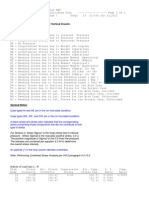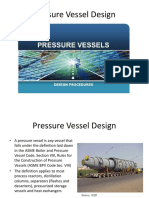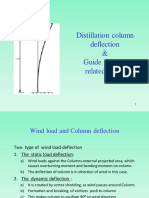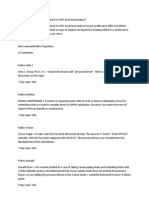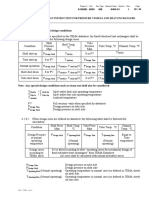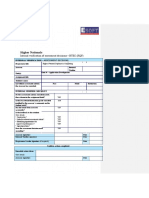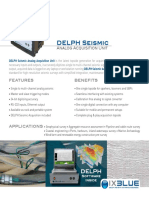PV Elite and CodeCalc Verification Manual
PV Elite and CodeCalc Verification Manual
Uploaded by
Mukesh ChopraCopyright:
Available Formats
PV Elite and CodeCalc Verification Manual
PV Elite and CodeCalc Verification Manual
Uploaded by
Mukesh ChopraCopyright
Available Formats
Share this document
Did you find this document useful?
Is this content inappropriate?
Copyright:
Available Formats
PV Elite and CodeCalc Verification Manual
PV Elite and CodeCalc Verification Manual
Uploaded by
Mukesh ChopraCopyright:
Available Formats
PV Elite and CodeCalc
Verification and Quality Assurance Manual
Version 2020 (22.0)
November 2019
Copyright
Copyright © 1993-2019 Hexagon AB and/or its subsidiaries and affiliates. All rights reserved.
This computer program, including software, icons, graphic symbols, documentation, file formats, and audio-visual displays; may be
used only as pursuant to applicable software license agreement; contains confidential and proprietary information of Hexagon AB
and/or third parties which is protected by patent, trademark, copyright law, trade secret law, and international treaty, and may not be
provided or otherwise made available without proper authorization from Hexagon AB.
Contains RealDWG™ by Autodesk, Inc. Copyright © 1998-2018 Autodesk, Inc. All rights reserved.
Portions of the user interface copyright © 2012-2018 Telerik AD.
U.S. Government Restricted Rights Legend
Use, duplication, or disclosure by the government is subject to restrictions as set forth below. For civilian agencies: This was
developed at private expense and is "restricted computer software" submitted with restricted rights in accordance with
subparagraphs (a) through (d) of the Commercial Computer Software - Restricted Rights clause at 52.227-19 of the Federal
Acquisition Regulations ("FAR") and its successors, and is unpublished and all rights are reserved under the copyright laws of the
United States. For units of the Department of Defense ("DoD"): This is "commercial computer software" as defined at DFARS
252.227-7014 and the rights of the Government are as specified at DFARS 227.7202-3.
Unpublished - rights reserved under the copyright laws of the United States.
Hexagon PPM
305 Intergraph Way
Madison, AL 35758
Documentation
Documentation shall mean, whether in electronic or printed form, User's Guides, Installation Guides, Reference Guides,
Administrator's Guides, Customization Guides, Programmer's Guides, Configuration Guides and Help Guides delivered with a
particular software product.
Other Documentation
Other Documentation shall mean, whether in electronic or printed form and delivered with software or on Intergraph Smart Support,
SharePoint, box.net, or the Hexagon PPM documentation web site, any documentation related to work processes, workflows, and
best practices that is provided by Intergraph as guidance for using a software product.
Terms of Use
a. Use of a software product and Documentation is subject to the Software License Agreement ("SLA") delivered with the software
product unless the Licensee has a valid signed license for this software product with Intergraph Corporation. If the Licensee has
a valid signed license for this software product with Intergraph Corporation, the valid signed license shall take precedence and
govern the use of this software product and Documentation. Subject to the terms contained within the applicable license
agreement, Intergraph Corporation gives Licensee permission to print a reasonable number of copies of the Documentation as
defined in the applicable license agreement and delivered with the software product for Licensee's internal, non-commercial
use. The Documentation may not be printed for resale or redistribution.
b. For use of Documentation or Other Documentation where end user does not receive a SLA or does not have a valid license
agreement with Intergraph, Intergraph grants the Licensee a non-exclusive license to use the Documentation or Other
Documentation for Licensee’s internal non-commercial use. Intergraph Corporation gives Licensee permission to print a
reasonable number of copies of Other Documentation for Licensee’s internal, non-commercial use. The Other Documentation
may not be printed for resale or redistribution. This license contained in this subsection b) may be terminated at any time and
for any reason by Intergraph Corporation by giving written notice to Licensee.
Disclaimer of Warranties
Except for any express warranties as may be stated in the SLA or separate license or separate terms and conditions, Intergraph
Corporation disclaims any and all express or implied warranties including, but not limited to the implied warranties of merchantability
and fitness for a particular purpose and nothing stated in, or implied by, this document or its contents shall be considered or deemed
a modification or amendment of such disclaimer. Intergraph believes the information in this publication is accurate as of its
publication date.
The information and the software discussed in this document are subject to change without notice and are subject to applicable
technical product descriptions. Intergraph Corporation is not responsible for any error that may appear in this document.
PV Elite and CodeCalc Verification and Quality Assurance Manual 2
The software, Documentation and Other Documentation discussed in this document are furnished under a license and may be used
or copied only in accordance with the terms of this license. THE USER OF THE SOFTWARE IS EXPECTED TO MAKE THE FINAL
EVALUATION AS TO THE USEFULNESS OF THE SOFTWARE IN HIS OWN ENVIRONMENT.
Intergraph is not responsible for the accuracy of delivered data including, but not limited to, catalog, reference and symbol data.
Users should verify for themselves that the data is accurate and suitable for their project work.
Limitation of Damages
IN NO EVENT WILL INTERGRAPH CORPORATION BE LIABLE FOR ANY DIRECT, INDIRECT, CONSEQUENTIAL INCIDENTAL,
SPECIAL, OR PUNITIVE DAMAGES, INCLUDING BUT NOT LIMITED TO, LOSS OF USE OR PRODUCTION, LOSS OF
REVENUE OR PROFIT, LOSS OF DATA, OR CLAIMS OF THIRD PARTIES, EVEN IF INTERGRAPH CORPORATION HAS BEEN
ADVISED OF THE POSSIBILITY OF SUCH DAMAGES.
UNDER NO CIRCUMSTANCES SHALL INTERGRAPH CORPORATION’S LIABILITY EXCEED THE AMOUNT THAT
INTERGRAPH CORPORATION HAS BEEN PAID BY LICENSEE UNDER THIS AGREEMENT AT THE TIME THE CLAIM IS
MADE. EXCEPT WHERE PROHIBITED BY APPLICABLE LAW, NO CLAIM, REGARDLESS OF FORM, ARISING OUT OF OR IN
CONNECTION WITH THE SUBJECT MATTER OF THIS DOCUMENT MAY BE BROUGHT BY LICENSEE MORE THAN TWO (2)
YEARS AFTER THE EVENT GIVING RISE TO THE CAUSE OF ACTION HAS OCCURRED.
IF UNDER THE LAW RULED APPLICABLE ANY PART OF THIS SECTION IS INVALID, THEN INTERGRAPH LIMITS ITS
LIABILITY TO THE MAXIMUM EXTENT ALLOWED BY SAID LAW.
Export Controls
Intergraph Corporation’s commercial-off-the-shelf software products, customized software and/or third-party software, including any
technical data related thereto (“Technical Data”), obtained from Intergraph Corporation, its subsidiaries or distributors, is subject to
the export control laws and regulations of the United States of America. Diversion contrary to U.S. law is prohibited. To the extent
prohibited by United States or other applicable laws, Intergraph Corporation software products, customized software, Technical Data,
and/or third-party software, or any derivatives thereof, obtained from Intergraph Corporation, its subsidiaries or distributors must not
be exported or re-exported, directly or indirectly (including via remote access) under the following circumstances:
a. To Cuba, Iran, North Korea, the Crimean region of Ukraine, or Syria, or any national of these countries or territories.
b. To any person or entity listed on any United States government denial list, including, but not limited to, the United States
Department of Commerce Denied Persons, Entities, and Unverified Lists, the United States Department of Treasury Specially
Designated Nationals List, and the United States Department of State Debarred List
(https://build.export.gov/main/ecr/eg_main_023148).
c. To any entity when Customer knows, or has reason to know, the end use of the software product, customized software,
Technical Data and/or third-party software obtained from Intergraph Corporation, its subsidiaries or distributors is related to the
design, development, production, or use of missiles, chemical, biological, or nuclear weapons, or other un-safeguarded or
sensitive nuclear uses.
d. To any entity when Customer knows, or has reason to know, that an illegal reshipment will take place.
Any questions regarding export/re-export of relevant Intergraph Corporation software product, customized software, Technical Data
and/or third-party software obtained from Intergraph Corporation, its subsidiaries or distributors, should be addressed to PPM’s
Export Compliance Department, 305 Intergraph Way, Madison, Alabama 35758 USA or at exportcompliance@intergraph.com.
Customer shall hold harmless and indemnify PPM and Hexagon Group Company for any causes of action, claims, costs, expenses
and/or damages resulting to PPM or Hexagon Group Company from a breach by Customer.
Trademarks
Intergraph®, the Intergraph logo®, Intergraph Smart®, SmartPlant®, SmartMarine, SmartSketch®, SmartPlant Cloud®, PDS®,
FrameWorks®, I-Route, I-Export, ISOGEN®, SPOOLGEN, SupportManager®, SupportModeler®, SAPPHIRE®, TANK, PV Elite®,
CADWorx®, CADWorx DraftPro®, GTSTRUDL®, CAESAR II® , and HxGN SDx® are trademarks or registered trademarks of
Intergraph Corporation or its affiliates, parents, subsidiaries. Hexagon and the Hexagon logo are registered trademarks of Hexagon
AB or its subsidiaries. Microsoft and Windows are registered trademarks of Microsoft Corporation. Other brands and product names
are trademarks of their respective owners.
PV Elite and CodeCalc Verification and Quality Assurance Manual 3
Introduction
Contents
Introduction .................................................................................................................................................. 6
Hexagon PPM Quality Assurance .............................................................................................................. 7
Software Purpose.................................................................................................................................... 7
Disclaimer ............................................................................................................................................... 7
Intellectual Property Statement ............................................................................................................... 8
Management/Organization ...................................................................................................................... 8
PV Elite Development ............................................................................................................................. 8
User Documentation ............................................................................................................................... 8
Product Support ...................................................................................................................................... 9
Software Issue Tracking/Resolution ....................................................................................................... 9
Software Verification ................................................................................................................................. 10
Test Control........................................................................................................................................... 10
Beta Tests ............................................................................................................................................. 11
PV Elite Test Jobs ................................................................................................................................. 12
Corrective Action Standard ................................................................................................................... 12
Post-Development Procedures ............................................................................................................. 13
Distribution Control ............................................................................................................................... 13
CodeCalc QA Checks ................................................................................................................................ 14
Introduction ........................................................................................................................................... 14
Shell and Head Checks ........................................................................................................................ 15
Nozzle Checks ...................................................................................................................................... 17
Flange Checks ...................................................................................................................................... 19
Cone Checks......................................................................................................................................... 22
Floating Heads Checks ......................................................................................................................... 23
Horizontal Vessel Checks ..................................................................................................................... 25
Leg and Lug .......................................................................................................................................... 25
TEMA Tubesheets Checks ................................................................................................................... 27
WRC 107 Checks.................................................................................................................................. 28
Pipe and Pad Checks ........................................................................................................................... 29
Base Ring Checks ................................................................................................................................ 29
Half-Pipe Check .................................................................................................................................... 30
Large Opening Checks ......................................................................................................................... 31
Rectangular Vessel Checks .................................................................................................................. 33
PV Elite Sample Benchmark Problem Sets............................................................................................. 36
Problem 1 - Natural Frequency Calculation .......................................................................................... 37
Problem 2 - Example of Stiffening Ring Calculation ............................................................................. 41
Problem 3 - Nozzle Reinforcement, Weld Strength, Weld Size ............................................................ 47
Problem 4 - Vessel under Internal and External Pressure on Legs ...................................................... 64
Problem 5 - Vertical Vessel with Wind and Seismic Loads .................................................................. 79
Problem 6a - ASME Section VIII Division 1 Sample Comparisons ...................................................... 93
Problem 6b - ASME Section VIII Division 2 Sample Comparisons ...................................................... 97
PV Elite and CodeCalc Verification and Quality Assurance Manual 4
Introduction
Problem 7 - EN-13445 Nozzle Reinforcement.................................................................................... 105
Index ......................................................................................................................................................... 111
PV Elite and CodeCalc Verification and Quality Assurance Manual 5
SECTION 1
Introduction
The PV Elite®/CodeCalc® Verification and Quality Assurance Manual provides a standard set of
PV Elite/CodeCalc jobs that are used in verifying both the operation of the software and the
accuracy of the result for each release of the PV Elite/CodeCalc package. The examples
presented in this manual are a representative cross-section of the jobs run by Hexagon PPM.
The jobs selected for this manual compare the PV Elite/CodeCalc output with results published
in industry journals and with results from other software products. The PV Elite/CodeCalc output
is (also) verified with hand and/or MathCad™ calculations.
The component-analysis part of PV Elite is called CodeCalc. CodeCalc-specific results can be
found in the Software Verification section of this manual. In all other sections, the software is
referred to simply as PV Elite.
This manual consists of two major sections: Hexagon PPM Quality Assurance and Software
Verification.
Hexagon PPM Quality Assurance describes the quality assurance procedures employed by
Hexagon PPM to ensure that PV Elite is producing correct results.
Software Verification explains a series of benchmark jobs that you can use to confirm
software accuracy. These jobs compare PV Elite output to published results, to output from
similar software, or to hand calculations. For each job in this section, a brief description of
the job and any special considerations are discussed. Following the discussion is a
graphical representation of the system with selected result comparisons. Because of the
volume of output, important results like required thickness, maximum allowable working
pressure (MAWP), and stress are listed in tables. Users interested in the entire output can
re-analyze the jobs as necessary.
The PV Elite development team is constantly testing and adding new test jobs to the QA
benchmark problem set. Currently, there are more than 800 test jobs run which test thousands
of different calculations. It is impractical to include all of these tests in this manual. As new
Quality Assurance procedures are published, they will be incorporated into the QA methods
employed by Hexagon PPM. Users with questions, comments, or suggestions are encouraged
to contact Hexagon PPM to discuss future revisions to this document. User requests for new
features are always welcome. By working with the user, the PV Elite development staff will
continue to develop a product that best meets the demands of pressure-vessel design and
analysis users.
PV Elite and CodeCalc Verification and Quality Assurance Manual 6
SECTION 2
Hexagon PPM Quality Assurance
Software quality assurance is generally a speculative pursuit because, no matter how much
testing is performed, the next test may reveal an error in the software. The goal of any quality
assurance standard is to perform enough testing to achieve such a level of confidence in the
software that errors are rare and unlikely. With this objective in mind, several organizations have
published guidelines for use in software quality assurance.
In This Section
Software Purpose .......................................................................... 7
Disclaimer ...................................................................................... 7
Intellectual Property Statement...................................................... 8
Management/Organization ............................................................ 8
PV Elite Development .................................................................... 8
User Documentation ...................................................................... 8
Product Support ............................................................................. 9
Software Issue Tracking/Resolution .............................................. 9
Software Purpose
PV Elite is a package of twenty applications that work together to design and analyze pressure
vessels and heat exchangers. The purpose of the software is to provide the mechanical
engineer with easy-to-use, technically sound, well-documented calculations that will expedite
and simplify vessel-design and re-rating tasks. The software also provides recent,
industry-accepted analyses of the designs.
Calculations in PV Elite are based on the latest editions of national codes such as the ASME
Boiler and Pressure Vessel Code, or other relevant industry standards that are not covered
directly by ASME VIII-1, VIII-2 or other codes.
Disclaimer
The PV Elite and CodeCalc Verification and Quality Assurance Manual is intended to
demonstrate Hexagon PPM quality assurance procedures. ASME inspections do not require the
tests and material discussed in this manual. Hexagon PPM is not responsible for qualifying or
validating user designs and calculations. Calculations are the responsibility of the Manufacturer
as discussed in ASME Section VIII, Div. 1 U-2(b). For additional information, refer to ASME
Section VIII, Div. 1 UG-90(b), UG-90(c), 10-5 and 10-15.
PV Elite and CodeCalc Verification and Quality Assurance Manual 7
Hexagon PPM Quality Assurance
Intellectual Property Statement
This manual and its contents should be considered proprietary. This material should not be
copied or distributed to other parties without the expressed written consent of Hexagon PPM.
Management/Organization
At Hexagon PPM, the Chief Technology Officer/Architect, Product Owner, Product Development
Manager, and Quality Assurance Manager oversee the development and testing of the software
product. Software development team members include: engineers, software developers, and a
technical writer. All members of the development team support customers and test the software
prior to each release. Specialized technical support representatives work closely with the
development team. In addition, an on-staff, certified Nuclear Quality Assurance (NQA) lead
auditor oversees the quality assurance program followed by the team.
PV Elite Development
Hexagon PPM is wholly responsible for all software made available to the public that bears the
Hexagon label on the distribution media.
Changes to PV Elite are made by or with the consent of the Product Manager. Additional
members of the software team include engineers, who interact at the same level and
communicate directly with the product manager. Therefore, all software issues can be brought to
the attention of the Product Manager quickly and easily.
Software engineers each bring a different kind of expertise to the team and write routines for
specialized functions in the software. For example, the source code to perform structural steel
checks may be written by an engineer at Hexagon PPM whose educational background permits
him to do this efficiently.
All members of the development staff provide customer support for PV Elite, directly or
indirectly. One member of the team is tasked with quality assurance procedures for each
release.
User Documentation
The PV Elite user has online access to documentation spanning all facets of the software,
including all of the ancillary processors and interfaces. The standard PV Elite documentation set
consists of the following documents:
PV Elite User's Guide
CodeCalc User's Guide
Quick Start Guide
These documents can be accessed from the Help tab in PV Elite. The PV Elite documentation
accompanies each new version of the program and is supplied in both PDF and online help
formats.
Contact information for Hexagon PPM is included in these documents, as well as displayed in
the help system, and in a variety of other locations in the software. We encourage users
PV Elite and CodeCalc Verification and Quality Assurance Manual 8
Hexagon PPM Quality Assurance
experiencing problems or confusion with the software to reference the documentation first, and
then contact us for further resolution and suggestions.
Product Support
Hexagon PPM welcomes input/suggestions from our users. Users having problems with our
software may freely contact Hexagon PPM through our customer support system, which is found
on our company website and on the News Feed tab in PV Elite.
Our Technical Support staff may ask users with a numerical/computational issue in PV Elite to
submit the job to Hexagon PPM. This allows our support staff to identify the problem and locate
the cause, and then contact the user for resolution.
Software Issue Tracking/Resolution
PV Elite supports standard practices for tracking released software issues, including:
Incorporating user feedback directly back into the development process.
Notifying users regarding hot fix or service pack updates issued throughout development
Following software release criteria based on issue review and prioritization.
PV Elite and CodeCalc Verification and Quality Assurance Manual 9
SECTION 3
Software Verification
This section describes the test methods through which PV Elite software team performs Quality
Assurance testing on PV Elite. In addition, the section describes test methods that you can
implement to validate your PV Elite program data against industry-standard benchmarks.
In This Section
Test Control ................................................................................... 10
Beta Tests ...................................................................................... 11
PV Elite Test Jobs ......................................................................... 12
Corrective Action Standard ............................................................ 12
Post-Development Procedures ...................................................... 13
Distribution Control ........................................................................ 13
Test Control
Currently in the United States there is no organization that formally establishes the credibility of
pressure-vessel analysis software. Therefore, software suppliers take on this responsibility.
Generally, there are two ways to establish that any software product is performing correctly:
Comparing product results to hand calculations.
Comparing results to previously verified results from an external source.
If these methods compare favorably to software-generated results, then the software is
assumed to be performing as expected. If the results do not compare favorably, the PV Elite
development team identifies the differences and corrects the problem.
Testing Process
Before a new version of PV Elite is released, the development personnel perform alpha-level
testing throughout the delivery cycle in a process called "continuous delivery". This means that
every month-long development cycle, items are worked on, tested, and verified before the item
is considered done. This involves checking the Fortran/C++ or assembler code and running of
basic test problems designed to test the functionality of the feature addition, error and abort
conditions, and so forth. Next, the development staff generates a series of alpha jobs that:
Test new features against existing software.
Run tests against industry standard programs, such as Compress™ and VVD™ teams.
Suggest to customers that they independently compare the results of PV Elite against their
own in-house program or spreadsheets.
Test new features against hand calculations.
Test new features against published literature, such as the ASME VIII-1, PTB-3, and other
codes.
Test the interaction between new features and features already existing in the software.
PV Elite and CodeCalc Verification and Quality Assurance Manual 10
You might also like
- Caesar Wrc107and297Document3 pagesCaesar Wrc107and297spiritizNo ratings yet
- Dennis R Moss 4th EditionDocument5 pagesDennis R Moss 4th Editionsenthil kumarNo ratings yet
- Design of Tooth Locked Quick Open Die Pressure VesselDocument4 pagesDesign of Tooth Locked Quick Open Die Pressure VesselSEP-PublisherNo ratings yet
- Pvelite OutputDocument44 pagesPvelite OutputRam MurtyNo ratings yet
- PV Elite 2014 Licensee Filename: Rectangular Vessel Rectves Analysis: New Rectangular Item: 1 8:09P Aug 25,2015Document7 pagesPV Elite 2014 Licensee Filename: Rectangular Vessel Rectves Analysis: New Rectangular Item: 1 8:09P Aug 25,2015Pressure VesselNo ratings yet
- PV Elite: User's GuideDocument620 pagesPV Elite: User's GuideSiva baalanNo ratings yet
- BOSS AccuScore Plus 90 CDocument166 pagesBOSS AccuScore Plus 90 CJamie Rush100% (1)
- Load Case Explanation in PV EliteDocument2 pagesLoad Case Explanation in PV ElitekuselanmlNo ratings yet
- Combined Stress Caclulation - PveliteDocument2 pagesCombined Stress Caclulation - Pveliterajeshvyas_510% (1)
- "Lifting - Lug" - Lifting Lug Analysis: Program DescriptionDocument3 pages"Lifting - Lug" - Lifting Lug Analysis: Program Descriptionnamasral100% (3)
- Note in WRC 107 Lifting Lug Calculation (Horizontal Vessel) - Intergraph CADWorx & AnalysisDocument2 pagesNote in WRC 107 Lifting Lug Calculation (Horizontal Vessel) - Intergraph CADWorx & AnalysisDinesh VaghelaNo ratings yet
- Balaji S - Static Equipment Design - 7 Years - Resume - NEWDocument5 pagesBalaji S - Static Equipment Design - 7 Years - Resume - NEWkanchanabalajiNo ratings yet
- VVD Info PDFDocument6 pagesVVD Info PDFVicky Gautam100% (1)
- Pressure Vessel ExampleDocument48 pagesPressure Vessel ExamplemohamedNo ratings yet
- How To Consider Sea Transportation LoadDocument7 pagesHow To Consider Sea Transportation LoadSharun SureshNo ratings yet
- WRC, PV Elite, NozzlePro Sign ConventionsDocument13 pagesWRC, PV Elite, NozzlePro Sign ConventionsADHIRAJ KOLINo ratings yet
- PVElite PDFDocument651 pagesPVElite PDFMahesh PanditNo ratings yet
- Pressure Vessel Design - ProceduresDocument62 pagesPressure Vessel Design - ProceduresLê Phạm HoàngNo ratings yet
- PV EliteDocument680 pagesPV Elitengocanh_songlongNo ratings yet
- ASME Section VIII, Division 2: Pressure Vessel Stress and Fatigue AnalysisDocument17 pagesASME Section VIII, Division 2: Pressure Vessel Stress and Fatigue AnalysisBernacleboy ID100% (1)
- Flange GradesDocument8 pagesFlange Gradesaateka02No ratings yet
- 1855 1Document2 pages1855 1hogoyoNo ratings yet
- Multi Layer Pressure VesselsDocument8 pagesMulti Layer Pressure VesselsprivatehomeNo ratings yet
- Allowable Nozzle LoadingsDocument3 pagesAllowable Nozzle Loadingskemo10No ratings yet
- Skid Frame Calculation Sheet: LPG MeteringDocument11 pagesSkid Frame Calculation Sheet: LPG Meteringidilfitri100% (1)
- Flange FVC DataDocument36 pagesFlange FVC Dataachillesntroy100% (1)
- Sec.6 - Class C Heat ExchangerDocument33 pagesSec.6 - Class C Heat ExchangerAgung Dewandaru MahatmantoNo ratings yet
- Design and Analysis of Pressure Vessel Skirt Considering Seismic Load As Per Uniform Building Code IJERTCONV4IS10007Document5 pagesDesign and Analysis of Pressure Vessel Skirt Considering Seismic Load As Per Uniform Building Code IJERTCONV4IS10007RSalehNo ratings yet
- Guide Support Issues For A Deflection ColumnDocument17 pagesGuide Support Issues For A Deflection ColumnSachin100% (1)
- 4DMechanical VesselDocument26 pages4DMechanical VesselBowo Edhi WibowoNo ratings yet
- NozzlePRO 14.1NewFeatures-2019ReleaseDocument13 pagesNozzlePRO 14.1NewFeatures-2019ReleasedelitesoftNo ratings yet
- WRC Load AnalysisDocument5 pagesWRC Load Analysisyogacruise100% (1)
- PV Elite Saddle AnalysisDocument4 pagesPV Elite Saddle AnalysismrosNo ratings yet
- PV Elite and CodeCalcDocument102 pagesPV Elite and CodeCalcRaúl R Rojas Torres100% (3)
- Nozzle Interference Error SolvingDocument2 pagesNozzle Interference Error SolvingSakthi Vel0% (1)
- ISO 4126-7-2004 Pressure Safety Valve (COMMON DATA)Document40 pagesISO 4126-7-2004 Pressure Safety Valve (COMMON DATA)Pushkar GopalNo ratings yet
- PVElite 2013 ManualDocument517 pagesPVElite 2013 ManualAnonymous UoHUag100% (1)
- Maximum Allowable Stress: Mechanical Design of Pressure VesselsDocument17 pagesMaximum Allowable Stress: Mechanical Design of Pressure Vesselsfauzi100% (2)
- External Nozzle Loads On Nozzle FlangesDocument3 pagesExternal Nozzle Loads On Nozzle Flangesrenji_dannyNo ratings yet
- Calculation ReportDocument229 pagesCalculation ReportDarioNo ratings yet
- Fixed Tubesheet Design ConditionDocument1 pageFixed Tubesheet Design ConditionPratik ThakkarNo ratings yet
- Flange Pad CalcsDocument4 pagesFlange Pad CalcstomNo ratings yet
- PVElite Nozzle SectionDocument24 pagesPVElite Nozzle SectionRichard Koehler100% (1)
- Sample UdsDocument8 pagesSample UdsPrince SharmaNo ratings yet
- PV Elite Training-Notes On PV EliteDocument25 pagesPV Elite Training-Notes On PV EliterakicbgNo ratings yet
- Asme Viii Div.2Document16 pagesAsme Viii Div.2rps1977100% (1)
- Wake Freequency CalculationDocument5 pagesWake Freequency CalculationManoranjan Kumar Choudhary100% (1)
- 7-12-0008 Rev6 (Lug Support For Vertical Vessel) PDFDocument1 page7-12-0008 Rev6 (Lug Support For Vertical Vessel) PDFsumit kumarNo ratings yet
- Fatigue Analysis of 6300 Liters Pressure Vessel by Using Cyclic ServiceDocument7 pagesFatigue Analysis of 6300 Liters Pressure Vessel by Using Cyclic ServiceFisul RahumanNo ratings yet
- Technical DataDocument48 pagesTechnical Datashekhar2681No ratings yet
- B04-F03 REV 1 March 2018 Pipe RailignsDocument4 pagesB04-F03 REV 1 March 2018 Pipe Railigns15150515715No ratings yet
- QAManualDocument112 pagesQAManualAditya JainNo ratings yet
- Intergraph Smart Licensing: Network Connectivity GuideDocument14 pagesIntergraph Smart Licensing: Network Connectivity GuideBilal BakkaliNo ratings yet
- Intergraph Smart 3D Interference Checking - InglésDocument13 pagesIntergraph Smart 3D Interference Checking - IngléswillramgesNo ratings yet
- Pod Graphics Processor Users GuideDocument71 pagesPod Graphics Processor Users GuideAsmaNo ratings yet
- Drawingsand Reports Reference Data GuideDocument2,095 pagesDrawingsand Reports Reference Data GuideArgenisNo ratings yet
- Intergraph Smart 3D: InstallationDocument228 pagesIntergraph Smart 3D: InstallationvrajakisoriDasiNo ratings yet
- 2 D Symbols GuideDocument613 pages2 D Symbols Guide손대현No ratings yet
- User's Guide: Version 2016 HF (11.0) March 2018Document144 pagesUser's Guide: Version 2016 HF (11.0) March 2018Anant JadhavNo ratings yet
- 2DSymbolsReferenceData 1Document347 pages2DSymbolsReferenceData 1ArgenisNo ratings yet
- Cyber Forensics and Investigation on Smart Devices: Volume 1From EverandCyber Forensics and Investigation on Smart Devices: Volume 1No ratings yet
- HP BIOS Configuration Utility (BCU) : User GuideDocument24 pagesHP BIOS Configuration Utility (BCU) : User Guidedaniel de los riosNo ratings yet
- TC-0301 - The Magic Bell - Proofread - Edited - 28082019Document12 pagesTC-0301 - The Magic Bell - Proofread - Edited - 28082019Razvan HincuNo ratings yet
- NCE-T HCIA LectureDocument95 pagesNCE-T HCIA LectureSayed Rahim NaderiNo ratings yet
- KhushiSingh VITVDocument1 pageKhushiSingh VITVkhushi singhNo ratings yet
- Unity Networking Frameworks - Feature ListDocument18 pagesUnity Networking Frameworks - Feature Listrahidmir165No ratings yet
- Horizon AdministrationDocument302 pagesHorizon AdministrationPham ChienNo ratings yet
- CN7021 Project TemplateDocument8 pagesCN7021 Project TemplatePallavi PalluNo ratings yet
- Papyrus Sys MLTutorialDocument64 pagesPapyrus Sys MLTutorialscribdNo ratings yet
- How To Run or Install MASM Software On Windows (32 or 64-Bit) Using DOSBox (With Video Tutorial) - TechzClubDocument19 pagesHow To Run or Install MASM Software On Windows (32 or 64-Bit) Using DOSBox (With Video Tutorial) - TechzClubHari krishnanNo ratings yet
- Sol Trigger NPJH-50619Document6 pagesSol Trigger NPJH-50619Kiki RamaNo ratings yet
- Scaling Memcache at Facebook - SlidesDocument28 pagesScaling Memcache at Facebook - SlidesgamezzzzNo ratings yet
- Manual Reproductor Boss en Es PTDocument204 pagesManual Reproductor Boss en Es PTRenzo BracamonteNo ratings yet
- Bill Format Computer Repair ServiceDocument4 pagesBill Format Computer Repair Servicehacorona20No ratings yet
- Call Up Letter SCC Bhopal For SSC (Tech) 63 Oct 2024 CourseDocument29 pagesCall Up Letter SCC Bhopal For SSC (Tech) 63 Oct 2024 Courseharshawarner31No ratings yet
- Siemens Documentation - Add Location - Multiple Locations by PickDocument1 pageSiemens Documentation - Add Location - Multiple Locations by PickanupNo ratings yet
- W.M.N Maheshika Wijesinghe Application Development Assigment Unit 30 Reg11179 Peoson No PDFDocument89 pagesW.M.N Maheshika Wijesinghe Application Development Assigment Unit 30 Reg11179 Peoson No PDFSuhail FaizalNo ratings yet
- An5481 Lorawan at Commands For Stm32cubewl StmicroelectronicsDocument48 pagesAn5481 Lorawan at Commands For Stm32cubewl StmicroelectronicsNguyễn Quang ThuậnNo ratings yet
- MDS Report Substances of Assemblies and Materials: 1. Company and Product NameDocument3 pagesMDS Report Substances of Assemblies and Materials: 1. Company and Product NameyatheendravarmaNo ratings yet
- Hand Gesture Based RGB LED Strip ControlDocument2 pagesHand Gesture Based RGB LED Strip ControlSruthi Reddy0% (1)
- ARNAV Class 12 Practical FileDocument62 pagesARNAV Class 12 Practical FileNeel GuptaNo ratings yet
- Name: - Tengku Muhammad Firdaus - ID: Section: - 01 - Date: - 16/11/2021 - Quiz 1Document2 pagesName: - Tengku Muhammad Firdaus - ID: Section: - 01 - Date: - 16/11/2021 - Quiz 1TENGKU FIRDAUSNo ratings yet
- Tutorial For Tree Simple (Agent Based Simulation Model Developed Using Netlogo)Document27 pagesTutorial For Tree Simple (Agent Based Simulation Model Developed Using Netlogo)Deputy Manager NishatabadNo ratings yet
- Lexmark Firmware Job AidDocument3 pagesLexmark Firmware Job Aidluismiguel1789No ratings yet
- Srinivas ChamarthyDocument4 pagesSrinivas ChamarthySidharth VarunNo ratings yet
- PDS Pipe Supports Eden InterfaceDocument106 pagesPDS Pipe Supports Eden InterfaceshanmugamNo ratings yet
- Owasp Mas ChecklistDocument40 pagesOwasp Mas ChecklistAlfaro EduardoNo ratings yet
- CROP RECOMMENDATION SYSTEM Review3Document13 pagesCROP RECOMMENDATION SYSTEM Review3ADUSUMALLIRAJIV 19BCD7101No ratings yet
- Delph Seismic Analog Acquisition UnitDocument2 pagesDelph Seismic Analog Acquisition UnitAtubrah PrinceNo ratings yet
- Fish Model: Anal Ding Maintains/Technical Ysis SRS Design - HLD CoDocument3 pagesFish Model: Anal Ding Maintains/Technical Ysis SRS Design - HLD CoRushikesh SanapNo ratings yet








